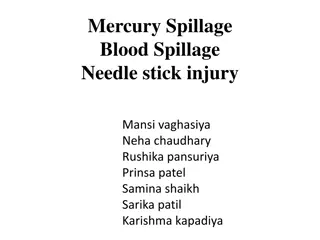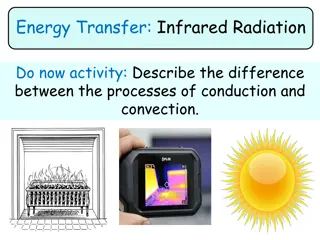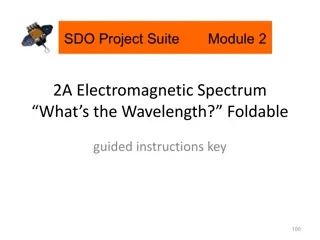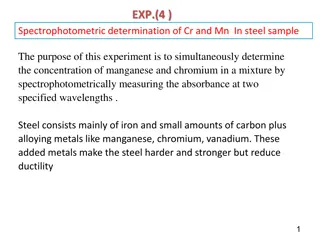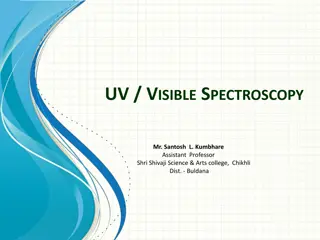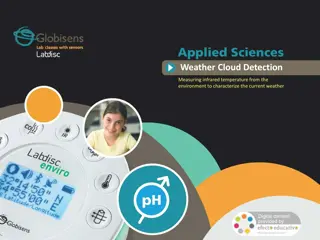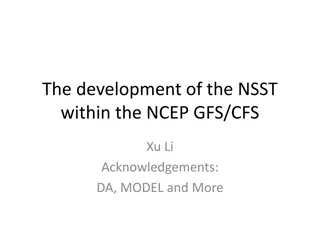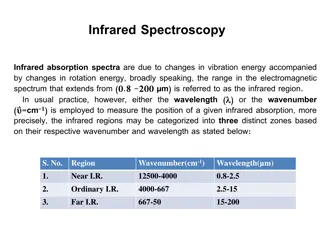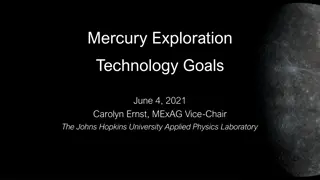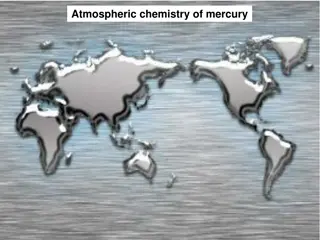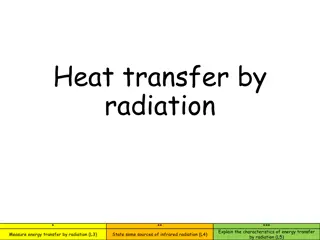Photometric Properties of Mercury's Surface at Visible to Near-Infrared Wavelengths
The study focuses on the photometric properties of Mercury's surface from visible to near-infrared wavelengths using data from MESSENGER's MASCS instrument. Observations were conducted at 14 sites to characterize the planet's photometric behavior, providing valuable insights into its geologic units. Different photometric regions were identified and analyzed, leading to preliminary interpretations and further research tasks.
Download Presentation

Please find below an Image/Link to download the presentation.
The content on the website is provided AS IS for your information and personal use only. It may not be sold, licensed, or shared on other websites without obtaining consent from the author.If you encounter any issues during the download, it is possible that the publisher has removed the file from their server.
You are allowed to download the files provided on this website for personal or commercial use, subject to the condition that they are used lawfully. All files are the property of their respective owners.
The content on the website is provided AS IS for your information and personal use only. It may not be sold, licensed, or shared on other websites without obtaining consent from the author.
E N D
Presentation Transcript
PHOTOMETRIC PROPERTIES OF MERCURYS SURFACE AT VISIBLE TO NEAR-INFRARED WAVELENGTHS Deborah L. Domingue, Mario D Amore, Sabrina Ferrari, J rn Helbert, Noam R. Izenberg
OVERVIEW The Data The Models Preliminary Results Preliminary Interpretations Remaining Tasks
THE DATA MESSENGER s Mercury Atmospheric and Surface Composition Spectrometer (MASCS) acquired photometric observations of Mercury at 14 distinct sites across the planet s surface for the purpose of characterizing photometric behavior from visible to near- infrared wavelengths. The objective of these observations was to provide a dataset for photometric standardization. The 14 MASCS photometric regions were divided into five distinct geologic units. Each geologic unit was modeled separately.
THE PHOTOMETRIC REGIONS I 15481546 1542 1540 1545 1544 1552 1544 1547 1549 darker smooth material smooth surface rim/proximal ejecta radial/discontinued ejecta intercrater material
THE PHOTOMETRIC REGIONS II 1550 1541 1553 1551 darker smooth material smooth surface rim/proximal ejecta radial/discontinued ejecta intercrater material
EXAMPLE REGION smooth surface rim/proximal ejecta radial/discontinued ejecta intercrater material Bright radially lineated ejecta of Mena crater - ref. area 1542 - crosscut the area, which is dominated by impacts of different size and degradation; several patches of smooth materials are observable, though sharp distinctions are difficult. 1540
DATA ORGANIZATION Within each photometric region only those MASCS observations where the footprint contained only one geologic unit were selected. The data from each photometric region were binned by geologic unit. The data from each photometric region for a single geologic unit were binned together. This is the primary data set examined and presented today. Today s results will compare the photometric properties between the five geologic units present in the photometric regions. The MASCS data were binned into 45-nm spectral resolution increments.
THE MODELS Each data set is being modeled with two distinct methods that follow similar modeling efforts applied to images from MESSENGER s Mercury Dual Imaging System [1]. The first method invokes the Hapke model [2-8], which is based on geometric optics and the equations of radiative transfer. The second method uses the equations described by Kaasalainen et al. [9] and Shkuratov et al. [10], which have been successfully applied to observations of Vesta [11], the Moon [10], and Mercury s global color mosaic [1]. References [1] Domingue, D. L., et al. 2015, Lunar Planet. Sci. 46, abstract 1832. [2] Hapke, B., 1981. J. Geophys. Res. 68, 4571 4586. [3] Hapke, B., 1984. Icarus 59, 41 59. [4] Hapke, B., 1986. Icarus 67, 264 280. [5] Hapke, B., 1993. Theory of Reflectance and Emittance Spectroscopy. Cambridge University Press, N.Y., 455 pp. [6] Hapke, B., 2002. Icarus 157, 523 534. [7] Hapke, B., 2008. Icarus 195, 918 926. [8] Hapke, B., 2012. Theory of Reflectance and Emittance Spectroscopy. Cambridge University Press, N.Y., 2nd Ed., 513 pp. [9] Kaasalainen, M., et al., 2001. Icarus 153, 37 51. [10] Shkuratov Y., et al., 2011. Planet. Space Sci. 59, 1326-1371. [11] Schr der, S.E., et al., 2013. Planet. Space Sci. 85, 198-213.
HAPKE MODEL I The basic form of the model was applied to the MASCS data set. This form does not include coherent backscatter opposition parameters, excludes the explicit porosity term, and assumes the shadow-hiding opposition terms are uniform across all wavelengths (the value of these terms are taken from disk-integrated studies of MDIS data). This form was chosen since there are no MASCS observations within the opposition surge and this is the form of the Hapke model that best described the MDIS photometry data. The advantage of this model is the theoretical correlation of parameter values to surface properties (though this has been brought into question in some laboratory tests by Shepard and Helfenstein (2011)).
HAPKE MODEL II Parameter w Value Range 0 1 Relation to Regolith A volume averaged single scattering albedo, the ratio of the amount of light scattered to the amount of light both scattered and absorbed. single-scattering albedo b -1 1 A Heney-Greenstein function parameter that governs the relative amplitudes of the forward and backward scattering components. single-particle scattering function amplitude c -1 1 A Heney-Greenstein function parameter that governs the partition of scattered light into forward or backward directions. single-particle scattering function partition coefficient BS0 0 1 The amplitude of the opposition effect due to the shadow- hiding mechanism. This is a single scattering mechanism. SHOE amplitude hs A measure of the width of the opposition effect due to the shadow-hiding mechanism, related to grain size distribution and filling factor within the scattering volume. SHOE width 0 40 (degrees) The mean slope angle averaged over an upper size limit defined by the angular resolution of the detector and a lower limit defined by the radiative transfer equations, typically of the order of 100 -1000 m (Hapke 2012). surface roughness
KAASALAINEN SHKURATOV (KS MODEL) Used the variation of this model that was shown to best describe the MDIS photometry measurements This form includes only three parameters: AN (Normal Albedo), phase parameter ( ), and disk function parameter (Cl). The correlation of parameter values to surface properties is predominately empirical, though the phase parameter can be related to surface roughness.
APPLICATION METHODOLOGY Each model was fit to the observations using a least squares grid search method that varied all parameters simultaneously. The best combination of parameters was found by minimizing the root mean square (RMS) between the measurement and the model predict. In the following graphs the geologic units are noted as: sm = smooth surface smd = darker smooth surface rew = intercrater material rim = rim/proximal ejecta ej = radial/discontinued ejecta
PRELIMINARY RESULTS HAPKE MODEL I Single? Sca ering? Albedo? 0.9? 0.8? 0.7? 0.6? sm? 0.5? w? rim? 0.4? rew? ej? 0.3? smd? 0.2? 0.1? 0? 300? 400? 500? 600? 700? 800? 900? 1000? 1100? wavelength? (nm)?
SYNOPSIS OF RESULTS Both models show model parameter variability with wavelength Both models show variations in parameter values with geologic unit, however . The KS model normal albedo parameter shows similar trends with wavelength between the geologic units while the Hapke model single scattering albedo does not. The Hapke model s surface roughness parameter and the KS model s disk function parameter (which is related to surface roughness) both show that the ejecta (ej) unit displays roughness values as a function of wavelength that are different from all the other geologic units. Surface roughness (especially as a function of wavelength) between the geologic units varies greatly in the Hapke model, but much less so in the KS model. The Hapke model scattering function parameters and the KS model phase function parameter show variations between the different geologic units. QULAITY OF FIT?!
RMS: EXAMPLE COMPARISON While both models show that the quality of fit decreases (higher RMS values) with increasing wavelength, the KS model has significantly lower RMS values than the Hapke model.
PRELIMINARY INTERPRETATIONS To first order, the KS model better describes the MASCS photometry as compared with the Hapke model. Additional tests to quantify the quality of fit are coming . Both models indicate variations in roughness between the geologic units Is there one set of model parameters that can be applied to the MASCS data set to provide a robust photometric correction? Answer: Perhaps ..
REMAINING TASKS The KS model parameters show the least variability between geologic units. The largest variability between geologic units for this model is seen in the Phase Function Parameter. Next Step: Combine all geologic units into a single data set and apply the KS model. This is the first step to determine if there is a single set of model parameters that can provide a photometric standardization across the MASCS data set. Is there photometric variability within the geologic units between the different photometric regions? Next Step: Model each geologic unit, within each photometric region, separately. This has been completed with the Hapke model, but application of the KS model remains to be performed. The quality of the model solutions needs further examination. Next Step: Perform a ratio analysis (measured versus modeled) for the current set of model solutions for the geologic units. Perform this same test on the combined data set described above, and below. Spectral Properties testing Next Step: Select pairs of spectra from the same geologic unit, from the same photometric region, taken under different incidence, emission, and phase angle conditions. Correct one spectrum of the pair to the geometry of the second spectrum of the pair. Examine how well the correction predicts the actual spectrum.




